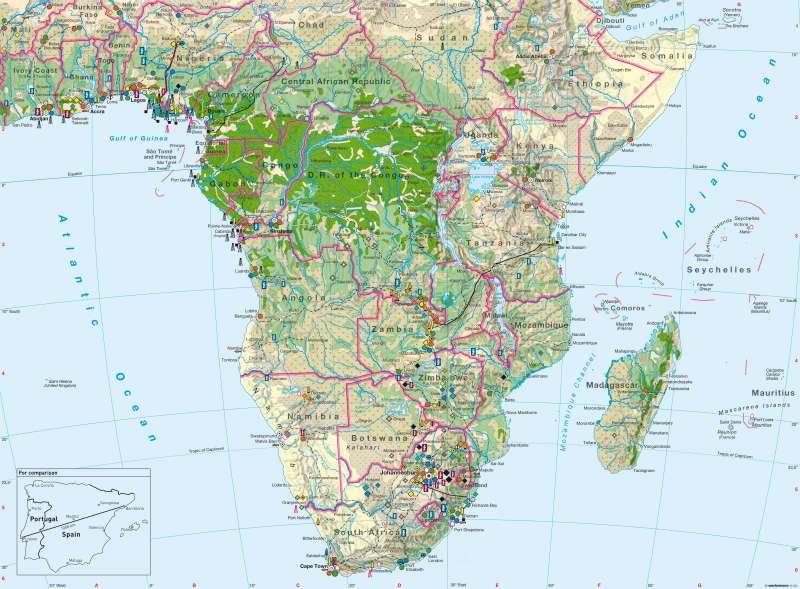Southern Africa — Economy
Southern Africa - Economy
978-3-14-100790-9 | Page 168 | Ill. 1

Information
As in the northern part of Africa, industry also plays a subordinate role in the southern half of the continent. The general map only shows a significant accumulation of mining and industry symbols in a small strip of land stretching from southern Central Africa as far as South Africa. In contrast to these are the rain forests, the extensive wet and dry savannahs of Central and Eastern Africa, and the semi-deserts and sand deserts in the north-east and south-west, where there is practically no industry. Agriculture in the southern half of the continent is also very unevenly distributed.Mining and Industry
The number and size of the symbols for mineral resources, industrial plants and energy production facilities give an indication of the economic importance of mining in the region between southern Congo and the Cape of Good Hope. Zambia and the Democratic Republic of the Congo (formerly Zaire) are among the principal international producers of copper, while at the same time the Congo is also among the world's largest suppliers of diamonds and cobalt.
Zimbabwe possesses a wide range of mining products. Botswana rose in the 1990s to become the world's most important supplier of diamonds; despite significant nickel, coal and copper deposits, the gemstones account for more than three-quarters of its export earnings. In Namibia too, diamonds are in first place; gold and silver, uranium, copper, lead and zinc are also produced. Angola, including its exclave of Cabinda, as well as Gabon, is among Africa's leading oil producers.
In terms of the size and variety of their reserves, and the global economic significance of their mineral resources, all these countries are surpassed by South Africa. The continent's most highly industrialized country possesses an unusually great wealth of more than five dozen different mineral raw materials, including diamonds, gold, uranium and various ores. Thanks to artificial irrigation, its agriculture is so productive that it not only covers the needs of its population but also produces a surplus for export. Also of great economic importance is animal husbandry for the production of milk, meat and wool, and fishing.
Based on mining and the associated concentration of population in the mining regions, a more substantial consumer goods industry emerged in South Africa, Zimbabwe, northern Zambia and southern Congo than in practically any other part of Africa.
In addition, partly in Zimbabwe but above all in South Africa — encouraged by the international boycott measures against the Apartheid system — alongside the primary industries a capital goods sector also developed from the 1960s in the fields of automobile construction, electrical industry and armaments. South Africa exported its goods to many African countries from an early stage, but today its main trading partners are the USA, Germany, Great Britain and Japan.
Agriculture and Animal Husbandry
The structure of vegetation and land use does not show the same latitudinal zoning as in the northern part of Africa. This is due on the one hand to the contrast between the tropical lowlands of the Congo Basin and the highlands of Eastern and Southern Africa, and on the other hand to the longitudinal structure of vegetation and land use zones in Southern Africa.
The contrast between the arid western side and the humid eastern side, with a semiarid interior, is caused by its location in the dry zone of the Southern Hemisphere, with the cold Benguela Current intensifying the dryness in the west and the warm Agulhas Current bringing moisture to the eastern side of the continent.
Agricultural activities are very unevenly distributed. In the tropical rain forest region, shifting cultivation and plantation agriculture appear in different places. The focal points of intensive land use and plantation agriculture are emphasised on the map.
Various factors are responsible for today's distribution into regions of tropical shifting cultivation or of intensive agriculture. In principle, tropical highland regions permit a combination of arable farming and animal husbandry. In the colonial era, these favoured regions experienced extensive settlement by white farmers, especially in Kenya, Angola, Zimbabwe and Zambia. The intensive agriculture that they introduced was continued after independence, often also by African farmers.
In South Africa the "maize rectangle" in the highlands as well as the wheat, wine and fruit growing regions in the south-west are still "white" farmland; in terms of technology it is comparable with American agriculture. Plantation agriculture spread on the coast and the banks of the great rivers of Southern Africa in the colonial era, with the cultivation of oil palms, rubber, coffee, sugar cane and sisal. In Central Africa, plantation agriculture has declined in recent years due to the neglect of replanting and the transport system; in Eastern Africa and South Africa on the other hand there has been an increase in foreign exchange earnings and an expansion in plantations.
Animal husbandry has also been severely limited south of the Equator by the spread of the tsetse fly. For a long time nomadic cattle breeding was dominant in the dry regions of Kenya and Tanzania, but in recent times more and more nomads have become settled. Zambia, Zimbabwe, South Africa and the highlands of Kenya have efficient cattle farming. In Botswana and Namibia, farms and ranches have replaced the traditional forms of animal husbandry.
B. Wiese; Ü: J. Attfield




